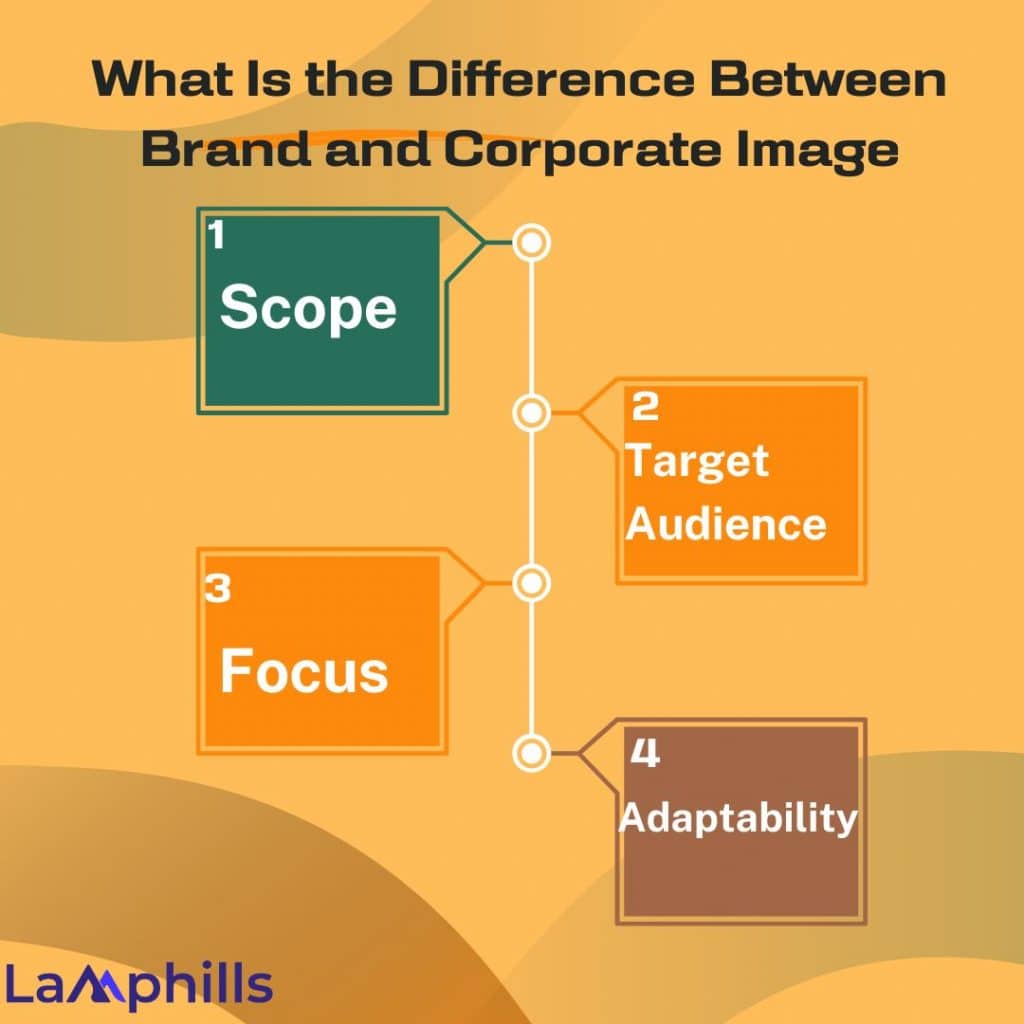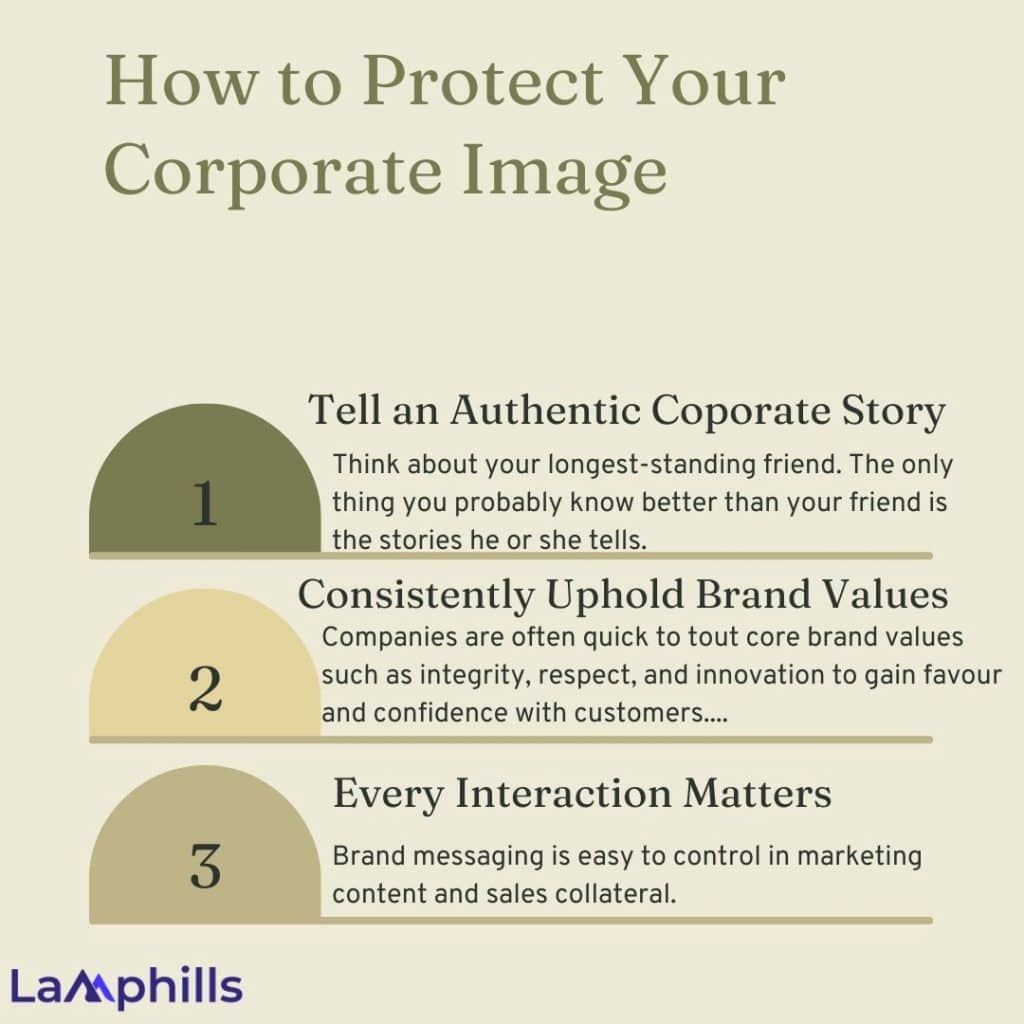A company’s corporate image is what people think of the company, the services it provides, and the products it deals in. The company’s performance, activities, and media coverage represent its corporate image. It refers to the goodwill or reputation the company has in the market and the minds of its clients. It may also be referred to as the public face of the company. Corporate image is one of the main factors influencing the company’s success.
A positive corporate image helps increase the company’s business. It also attracts shareholders, customers, and business partners. This article will further buttress the importance of corporate image, its types, and the differences between brands.
Key Points
- A company’s corporate image can be defined as an image that people hold about the company, its products, and its services.
- The importance of corporate image includes customer loyalty and strong relationships, enhancing the performance of products, influencing the actions of the employees of a company, and strengthening the business image of the company.
- Factors influencing corporate image include company name, logo, slogan, typography and colors, web, values, history, and reputation.
- The principles of corporate image encompass various aspects that collectively shape how a company is viewed. Here are the key principles: consistency, authenticity, reputation management, quality and reliability, and corporate social responsibility.
- To protect your corporate image, you must be prepared with the following procedures: tell an authentic corporate story, consistently uphold brand values, and make every interaction matter.
What Is Corporate Image?
A company’s corporate image can be defined as an image that people hold about the company, its products, and its services. People sometimes call it corporate reputation or corporate identity. Marketing, advertising, branding, and an organization’s behavior all help shape its professional image. The way the business interacts with its customers can also have a substantial impact on its image. Many businesses prioritize customer service because of the direct effect this can have on their public image.
Company image is important for businesses of all sizes, but people often associate it with large and well-known organizations with a well-established reputation. Despite this, any public-facing business has a company image, even if its leaders and employees aren’t actively developing it. Aspects like the company name and the appearance of its website are elements of the company image that customers, suppliers, and partners all experience.
Why Does a Company’s Image Matter?
Nowadays, most people support brands that share the same values as them.
In fact, brand values are often a critical factor in someone’s purchasing decision. For instance, 83% of millennials find purchasing from companies that align with their values important.
Additionally, Weber Shandwick, one of the world’s leading global public relations firms, found that global executives, on average, attribute 63% of their company’s market value to their overall reputation.
More than likely, you also know this on a quantitative level. Consider, for instance, the last time you purchased a product or service for which you could have found a cheaper alternative.
Perhaps you purchased a new iPhone or splurged on that Patagonia jacket you’ve wanted for a while. Ultimately, you likely made that purchase decision partly due to the brand’s reputation and overall image.
That is why corporate image matters — it can influence whether consumers want to buy from you and increase brand loyalty when people feel your values align with theirs.
Importance of Corporate Image

The corporate image of a company plays an important role in the success of the company. Customers’ actions are largely influenced by the corporate image of a company.
It is difficult to build a strong and positive image of the company in such a cut-throat competitive environment, and once the image is ruined, it is nearly impossible to gain it back.
Therefore, watching and planning your actions is important to build a positive company image. Next, you will learn why a positive corporate image is important.
#1. Customer Loyalty and Strong Relationship
Nowadays, people have many options when deciding to buy one product. In a highly competitive environment, companies use various strategies to gain the loyalty of their customers and attract new customers.
A positive corporate image can help you attract customers and gain loyalty. For example, nowadays, companies participate in social activities such as helping the poor, providing education to underprivileged children, or activities associated with environmental causes.
Contribution to such activities creates a positive image of the company in people’s eyes.
#2. Enhance the Performance of Products
The performance of products a company produces is largely impacted by its image in marketing. People have become aware more than ever, and they also have options to reject the products of one company and choose the products of another company.
A company with a positive image can easily sell its products by investing less in advertising. People have blind trust in the quality of the Phones and other technological devices produced by the Apple company.
Since its inception, Apple has managed to sustain a positive corporate image and has always presented itself as a leader in the smartphone market.
#3. Influence the Actions of the Employees of a Company
Employees of a company represent the company in the market, and their actions play an important role in building or ruining the image of a company. However, it is not wrong to say that a company’s corporate image also influences its employees’ actions.
If employees are associated with a company with a strong and positive corporate image, then they will feel liable to act accordingly so that they will not harm the image of the company.
#4. Strengthen the Business Image of the Company
People are skeptical when it comes to investing their money. Their investment decisions are largely influenced by the corporate image of the company. A bad corporate image will harm sales and repel investors.
Next, let’s see the factors that can influence corporate image
What Are the Factors That Influence Corporate Image?
Many factors, tangible and intangible, make up a certain corporate image. These are some of the most important:
- Company name: It is the first impression customers receive from a company. It is recommended that it be related to commercial activity and attractive enough to generate interest. Also, keep it short and easy to remember.
- Logo: It must convey the business idea and consider the company’s target and competitors. It has to be understandable by the public and attractive to potential clients. In addition, at the image level, it must attract attention and take care of the design.
- Slogan: It has to be innovative and creative and, at the same time, talk about the benefits of the product. It summarizes your slogan and defines your brand, so it must be meaningful and ingenious.
- Typography and colors: Although they may seem less important, the typeface and colors also serve to communicate. Each choice has a meaning that must identify and match the brand.
- Web: Besides being a fundamental tool for marketing efforts in the digital age, the page must respond to the same principles as the logo, the slogan, the chosen color range, or the language. Otherwise, building the corporate image we seek would not make sense.
- Values: The corporate image is not only tangible aspects but also the values that identify it. The more s and the customers identify with the brand’s values, the greater the company’s benefit in terms of communication and image.
- History and reputation: The reputation of companies for all the mistakes or positive acts carried out during their history will significantly influence a good or bad brand image.
What Are the Principles of Corporate Image?
The principles of corporate image encompass various aspects that collectively shape how a company is viewed. Here are the key principles:
- Consistency: Maintaining a consistent message, visual identity, and behavior across all communication channels and interactions is crucial. This includes logos, color schemes, typography, tone of voice, and messaging. Consistency helps in creating a recognizable and reliable image.
- Authenticity: Authenticity involves being genuine and transparent in all actions and communications. Companies should ensure their promises align with their actions and are honest about their capabilities and limitations.
- Reputation Management: Building and maintaining a positive reputation is essential. This involves actively managing how the company is perceived by handling public relations, responding to crises effectively, and engaging positively with stakeholders. Read also: 10 Reputation Management Companies Every Brand Needs on Speed Dial
- Quality and Reliability: Providing high-quality products or services consistently enhances the corporate image. Reliability in delivery, customer service, and overall performance builds trust and loyalty.
- Corporate Social Responsibility (C.S.R.): Demonstrating a commitment to social and environmental responsibilities can significantly improve corporate image. Engaging in sustainable practices, supporting community initiatives, and ethical business operations positively impact the company.
How to Improve Your Corporate Image
You might want to improve a company’s professional image in some circumstances. This might be because its image requires more development or because you want to improve how the public perceives the brand. The organization might also change its priorities or business direction.
In some cases, this might mean adjusting its public image is necessary. This guidance can help you develop a positive and authentic image for an organization and maintain it across the whole business. These steps are useful for new businesses developing a company image for the first time and for more established businesses aiming to adjust their image.
#1. Identify Your Company’s Purpose
If you truly want to build a loyal following for your brand and, in turn, strengthen your reputation, your company’s core message should focus on your purpose — not how you make your product or what your product is.
This notion that people buy the “why” behind your organization — not the “what” or “how” — isn’t just some idealistic trend catching fire in the business world today, though. It’s actually rooted in human biology.
The most primal part of the brain is called the limbic system, which controls all decision-making. It also happens to control all our emotions and feelings. So, resonating with your audience will also appeal to the part of the brain that’s responsible for action. In other words, you can drive behavior if you can evoke emotion.
Conveying a clear and convincing purpose through all your brand’s actions will forge the emotional connection required to persuade an audience to support you. And the more people who support you, the stronger your reputation will become.
#2. Make Sure You Can Walk the Walk
Sometimes, brands that want to reap the rewards of being a mission-driven company don’t actually adhere to the values they claim they’re so passionate about. But even though being a quasi-mission-driven company can attract new customers, once they uncover your hypocrisy, it’s almost impossible to retain them.
A Yale psychology study suggests that highlighting your morality is a shortcut to high status. But if people realize you don’t actually possess the traits that shot you up the social ladder, they’ll lose trust in you and respond harshly to your deception.
Before you start boasting about your company’s dedication to putting the customer first, ensure your actions align with these values or that you have a plan to do so.
#3. Take Ownership of Mistakes
Brands sometimes make mistakes, and taking ownership of them is important if you want to improve the company’s image. Taking responsibility for mistakes and correcting them helps you earn customers’ trust and can limit the damage to the company image that a mistake can cause. If the organization starts a new policy or releases a new product that causes a negative reaction from customers, reversing the decision can positively impact the brand image. Doing this shows customers you’re listening to them and want to meet their needs.
#4. Offer the Best Customer Service Possible
For many customers, one of their first interactions with your brand is through a customer service representative — so customer service plays an undeniably critical role in corporate image.
Customer service representatives can demonstrate your company’s values in their actions and words. For instance, consider Glossier’s customer service department (known as the gTEAM), which is responsible for responding to customer messages on social media and creating personalized experiences for each customer who reaches out.
This type of authentic, customer-first attitude is a small example of a bigger Glossier core value: “Devoted to the Customer.” Ultimately, each interaction your customer has with your company has the power to form their entire perception of your brand — and those customers will share both positive and negative feedback with friends. For this reason, customer service is a vital component to consider when improving corporate image.
#5. Keep Your Website and Social Media Current
For most businesses, their image changes over time, and you must keep the brand’s website and social media accounts current to reflect this. Customers often make fast judgments when they first view the organization’s website or social media accounts, and this might also be the first time they notice the brand. Keeping these platforms up to date ensures customers get an accurate impression of the company’s current image. It’s worth evaluating whether these channels give customers an accurate impression and deciding whether only small changes or a larger overhaul are necessary to make it more accurate.
#6. Adhere to Your Values
To create a strong and positive image, the business must adhere to the values it promotes. The values the business promotes might attract new customers, but practicing these values is essential for retaining these customers and continuing to attract more. Showing the organization’s actions align with its values is also important for building trust. Before publicizing company values, evaluating how closely company actions align with values is worthwhile. If there’s a difference, it’s wise to implement a plan to make behavior match the values.
How to Create a Brand Style
Creating a comprehensive brand style guide is essential for maintaining consistency in your brand’s visual and communicative elements. I have provided a step-by-step template to help you create a professional and detailed brand style guide.
Lamphills Brand Style Guide Template
Examples of Corporate Image
Every graphic designer around the block has heard the expression “corporate image.” Corporate image encompasses everything about a company that’s visible (visual communication, product advertising, etc.) and also strongly influences corporate identity, in which it plays an important part.
A company speaks and communicates through its image and does so predominantly using graphic design. Here are some examples of great corporate image design from recent years.
#1. Mudec: A Museum for People

Milan’s Mudec, or Museum of Cultures, is a great example of how corporate image is closely tied to an organization’s environment. Mudec was founded in 2015 and immediately established itself as one of the most important museums in Milan and northern Italy. It is housed in the post-industrial spaces of the former Ansaldo Factory, which have been transformed to create a cutting-edge museum where graphic design and architecture blend together perfectly.
Studio FM has created an unmistakable Italian corporate image that is modular and, like Merck’s, is not only able to make the museum recognizable but also to tell its story and promote it.
The idea that corporate image is a living thing, a dynamic and evolving system, is a new concept that graphic design took a while to grasp.
The Mudec capital “M” theme – which resembles a sort of ancient mask – offers myriad possible variations and opportunities for visual playfulness.
Just as the font chosen becomes the tool for narrating the exhibitions and permanent collection, the role of the corporate image is not simply to make brochures and leaflets pretty but to create a more complete experience for those coming into contact with the museum.
#2. Tiffany & Co.: Sophistication in Simplicity

One of the world’s most famous brand identities, thanks in no small part to the classic film starring Audrey Hepburn, belongs to New York jewelers Tiffany & Co.
Its signature sea green, refined lettering makes it one of the world’s most recognizable brands: the corporate identity follows these rules of elegance and minimalism, paying maximum attention to a handful of details.
While Tiffany & Co.’s corporate image was graphically sound, the fierce competition in the luxury market led the firm to bring in Pentagram, arguably the world’s best graphic design agency, to see what could be improved in its image.
The changes Pentagram made are almost imperceptible to the consumer’s eye, but they created a harmony between previously missing elements.
For example, they redrew the logotype by hand to make it look like a hot-metal typeface. They also subtly made over the packaging, reducing the size of the logo on bags and boxes by 40% and switching from printing to foil stamping.
You can read the full redesign story for this famous brand on the Pentagram website.
#3. Merck: Big Pharma Gets a More Human and Creative Face

A few years ago, German pharmaceutical giant Merck hired the Futurebrand agency to overhaul its brand image. The result was unique and revolutionary in the industry.
Merck’s head of branding, Axel Loeber, explained the rationale behind the new look, unveiled at the end of 2014: “Science is such an exciting thing; why does it always look so dull in these gloomy pictures?”.
The colors and lettering of the new logo evoke the cellular world that pharmaceutical research explores and, above all, Merck’s creativity, which makes the firm stand out from its competitors in the sector.
Loeber continues: “When you look at branding in this industry, they all use the same conventions: lab coats with a hi-tech appearance, pharma connotations, producing things in a highly regulated area. You really can’t show the product, so the solution is to bypass the issue and show the production process, making it difficult for companies like us, companies that are very specialized and don’t dominate the market, to set ourselves apart. We, therefore went much further than anyone might have expected with our rebranding.”
Merck opted for an organic-looking design that uses many colors and interchangeable shapes. The result is a corporate image that’s very POP, but also flexible and easily adaptable to various formats, including digital.
It’s an extremely creative corporate image with clear advertising and product design guidelines.
#4. Nike: The Quintessential Modern Brand

Nike is already a classic brand. It pioneered the idea that the logo is more important than the product. As Naomi Klein notes in “No Logo,” Nike constantly sells us pieces of its brand image, as if we were purchasing a fragment of the Berlin Wall for every product we buy.
Every time we encounter the Nike brand, we come into contact with its idea of sport: an activity for all that goes beyond competition, bringing out the best in each of us when we adhere to the motto “Just do it.”
All this is embodied by the minimalist and enigmatic Swoosh trademark.
The entire Nike corporate image revolves around this mark: the minimalist typeface accompanies the Swoosh without stealing the show; initially, the Futura font was used, but it has since been changed to Trade Gothic.
The base colors are black and white, but occasionally, depending on the design and product, other palettes are used, but things are always kept simple and clear.
Brochures and catalogs maintain this simplicity and clarity too: doing all the talking are product photos and testimonials (another Nike innovation was to base marketing around super-star athletes and their image, like basketball legend Michael Jordan) and the soundbites blown up and written in capitals (as if yelled or carved into rock).
Minimalism and simplicity in communication are rules applied across every part of the company worldwide. Attention to materials, logo proportions, and the balance between elements make Nike’s vast graphic system robust and coherent: its simplicity makes it easy to adapt and use for any event or project.
What Is the Difference Between Brand and Corporate Image

Does your company have a strong brand, or is it just a well-known name? Is there any difference between your brand and your corporate image? If these questions have crossed your mind, you’re not alone. While brand and corporate image work in tandem, there are key differences to understand;
#1. Scope
Brand Image: Connected to specific products or services. A company might have several brands, each with its distinct image.
Example: The brand personality of Nike Air Jordans is associated with athletic excellence, status, and urban style. This differs from the image of Nike’s running shoes, in which brand identities are centered around innovation, performance, and support.
Corporate Image: Reflects the company as a whole – its mission, how it conducts business, and how it treats stakeholders.
Example: Nike’s corporate image includes its commitment to sustainability. This broader image impacts consumers’ perception of all its products, even if a specific item wasn’t made with recycled materials.
#2. Target Audience
Brand Image: Primarily targets the customers likely to purchase the specific product or service.
Example: A luxury skincare brand strategy will likely target consumers interested in high-end beauty with messaging about exclusivity and indulgence.
Corporate Image: Must consider diverse stakeholders with different priorities.
Example: Nike’s company culture must resonate with investors interested in profitability, employees seeking fair labor practices, and a public concerned about environmental impact and social justice.
#3. Focus
Brand Image: Evokes feelings and associations to drive connection and purchase decisions.
Example: Coca-Cola’s visual identity relies heavily on nostalgia, happiness, and sharing special moments.
Corporate Image: Stresses the company’s values, practices, and overall societal impact.
Example: Patagonia’s corporate image is deeply tied to environmental activism and sustainable production, influencing consumer perceptions of individual garments.
#4. Adaptability
Brand Image: More flexible and responsive to market trends.
Example: A fast-food brand could revamp its image to emphasize freshness and healthier options to reflect changing consumer preferences.
Corporate Image: Built on the foundational elements of a company, therefore slower to change.
Example: A company with a history of workplace discrimination can’t erase that reputation overnight. True change requires consistent, demonstrated action over time to rebuild its corporate image.
How to Protect Your Corporate Image

Once you craft your corporate image, you need to protect it. The more successful you are, the more jealous competitors, angry customers, and those with an agenda will attack you. You have to be prepared with the following three sets of procedures.
#1. Tell an Authentic Corporate Story
Think about your longest-standing friend. The only thing you probably know better than your friend is the stories he or she tells. That’s because people tend to tell the same stories about themselves repeatedly. They’re not trying to bore you; they’re trying to make a point about who they are and what they stand for.
In other words, they feel the stories characterize them well. Brands are no different. The stories about brands tend to say a lot about their character, what they stand for, and why they’re special.
Brand stories are valuable because they package and portray brand personality and meaning unlike anything else. And people love stories, so keep telling them.
#2. Consistently Uphold Brand Values
Companies are often quick to tout core brand values such as integrity, respect, and innovation to gain customer favor and confidence, but to be credible, brands must live these same values when interacting with employees.
Internal interactions and actions influence how employees feel about your brand. If a brand claims to be honest but fails to be transparent with employees, its promise falls short. If a brand claims to be innovative but fails to update its hiring practices, its promise falls short.
The importance of this should go without saying because you rely on your employees to accurately represent your brand to customers on a daily basis. Wisely branded organizations begin with their core values in mind to determine how they treat and recognize their employees. It’s another way to promote a positive brand image in an increasingly competitive marketplace.
#3. Every Interaction Matters
Brand messaging is easy to control in marketing content and sales collateral. But what does your team say about your brand when they’re off-script? Casual conversations between employees and others no doubt impact your brand.
The reality of this can be daunting because a brand can’t control what is said about it, but the truth is brands can make a concerted effort to guide what is said. The best way to do so is by ensuring your audience and employees know, like, and trust your brand.
Read also: How to Protect Your Brand Online & Offline (Expert Tips)
Bottom Line
Once you improve and protect your Corporate Image, you can benefit greatly by implementing measures to leverage the positives. Enhancing your image basically involves communicating your successes to the widest possible audience. You excerpt testimonials, awards, and other accolades in your marketing materials, on your Web site, in social media, and in visible physical (and virtual) spaces around your business.
When your various publics come in contact with this information, it will make a positive brand impression that will likely cause them to buy what you are selling and tell people they know through their networks. In this way, you can leverage your corporate image to increase your business and make positive impressions on customers, prospects, future employees, vendors, and all your constituents. A good corporate image will provide a solid foundation for a successful business and career. I wish you the best of luck.
Similar Articles
- Top Rebranding Strategies That Sparks Massive Business Growth
- Branding Sentiment Analysis: Everything You Should Know
- Employee Branding in 2024: Top 9 Trends No Company Can Ignore (According to Experts)






